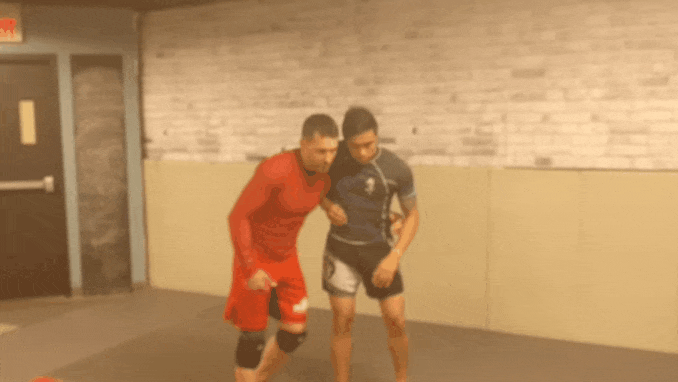Ahh overhooks and underhooks. They go together like peanut butter and jelly, spaghetti and meatballs, Ritchie and ladies night at the lamplighter. But unlike that last example, this is a relationship we can seek to understand. The first thing we need to know is how the two aspects work. We need to know what the tools do, then we can understand how to use them.
The underhook has two main jobs. It can pop people up. This is done with the front of the hips. Think lateral revolution. It can also bump people up. This is done with the back of the hip. Think O goshi.
The underhook also offers the option to drop down and attack the legs with singles, doubles, knee taps, etc if standing and threatens the back take if already grounded.
The overhook also has two main jobs.
It also can bump people. Although not as comfortably as with the underhook the underhook works fine.It can also depress people and force their face toward the mat.
It is harder to drop and attack the legs while standing off an overhook but somethings, ankle picks etc. are still an option. If already grounded the overhook stops the back take and can offer certain choke set ups.
For now though our main point is this, underhooks are good at lifting, overhooks are good at smashing.
The interaction between overhooks and underhooks is a bit like rock paper scissors with hip position being the third element. That doesn't really make sense but the point is either can win depending on who has better hip position. If the under can build their hips in close, they will have the advantage and should win the exchange. If the over can keep distance between the hips, they will be able to build pressure in the back of their opponents shoulder and smesh them, and they should win the exchange. So again, like Ritchie at the lamplighter, it's all about the hips. The overhook can exert tremendous pressure on the underhook, but only if it can apply that pressure to the back of the shoulder. If the under can get close and tight, the overhook is negated. The over needs to find another solution, frequently a kick up to fix the problem ( think uchi mata).
When things are going well for the over one of the best options is to run the under to front headlock. The over can initiate this sequence themselves with a kickup, but it can also begin when the under tries to move below the pressure and attack the legs or build back up. The over will turn the hip in hard, and slide their inside foot out front so that they are on a diagonal, putting all their weight into the under. From here they step the outside foot over to take front headlock, remembering to keep the back of the head in the middle of their chest. This two step pattern keeps weight on the opponent the whole time, never opening up to the double. This motion is a big part of playing the over.
The under has more uses on the ground. One of the most common is as a set up for a side control escape. If the bottom player is able to dig for the far side underhook they can then bridge, get to their knees and attack the legs or the back. Where they come up should resemble that sweep single position we have been looking at so much lately. Although the under will initially be high on the ribs, at the first chance it needs to come down below the waist or it is going to have problems.
As the top person in this exchange, we have a few options. First, if the bottom player leaves the underhook high up on body, we are going to run the same sequence we hit standing. Dig in for a strong overhook, weight it and take a big step through, then a second step across to front headlock.
As the bottom player, what we really want to do is deny the overhook at all we do this by spending as little time on the body as possible, instead fighting to the legs and shelving the foot on our hip quickly.
Sometimes even if the bottom person did the right thing and dropped the overhook to the legs we can reach down and pull it back up once again making the overhook usefull. Again we smash and run to front headlock.
In the event that we cannot pull the arm up easily we need another plan. First we need to not be taken down. Our inside hand goes to the back of the head and we smash their face into the mat. At the same time our outside foot needs to pop up and away so it can't be easily grabbed. this should put us is a position where we are leaning back sitting on the bottom players shoulder. We the free hand, (don't take pressure off the head) we make sure to clear the grips from our knee down to our ankle. This allows us mobility enough to reach back behind to hit the switch. The foot should pop out on it's own but if it takes a second, don't panic. We are in a dominant position.
Here is a video of Ritchie and I from a while back. He turns to guard as I hit the switch but I still end up on top.
This is all good when things are still on the ground. But sometimes it runs back to standing quickly. It is not uncommon for a good wrestler to be able to build through the pressure from the overhook and get back to their feet if they have good hip and strong shoulders. Our cross step intending to run to font headlock now becomes a way to keep our opponents from running the double. If they come up soft, smash them back down, but if they run hard seeking the body lock and are moving us across the mat, it is a prime opportunity to throw with Podkhvat. As they reach with the far arm, we collect the elbow, take a step out front planting our leg like a pole vault and when we feel our collective weight move over that foot we throw the reap.
Here is Craig Jones hitting almost this exact sequence. His opponent gets a little deeper into the takedown attempt but Craig draws his arms up and hits the cleanest throw of the year.
As always, credit where credit is due, 80% of this material comes from attending Rdojo camps and 20% from Kolat's amazing videos. If you are not yet on the Reilly/Cary hype train, get a ticket.











